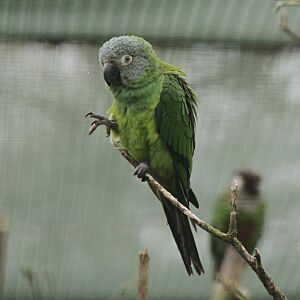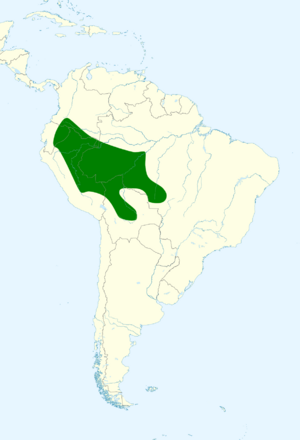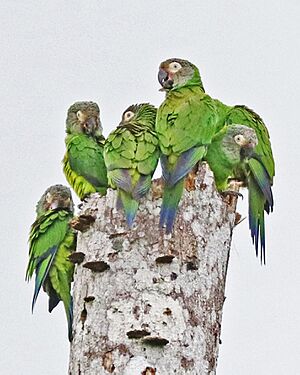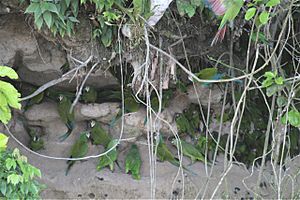Dusky-headed parakeet facts for kids
Quick facts for kids Dusky-headed conure |
|
|---|---|
 |
|
| At Beale Park, Reading, Berkshire, England | |
| Conservation status | |
| Scientific classification | |
| Genus: |
Aratinga
|
| Species: |
weddellii
|
 |
|
| Synonyms | |
|
Conurus weddellii Deville, 1851 |
|
The dusky-headed parakeet (scientific name: Aratinga weddellii) is a small green parrot. People who raise birds sometimes call it the Weddell's conure or dusky-headed conure. This bird lives in the western Amazon basin of South America. It has a dusty grey head.
You can find these parakeets in places with trees. Their home stretches from southeastern Colombia down through eastern Ecuador, eastern Peru, and southwest Amazonian Brazil. They also live in central Bolivia. They like open areas like várzea (flooded forests), forest edges, and small patches of forest. You might even spot them in coffee plantations. These birds are quite common. Because of where they live, they are safer than many other Amazonian animals. Experts like BirdLife International and IUCN say they are of least concern. This means they are not in danger of disappearing.
Contents
What Does the Dusky-headed Parakeet Look Like?
This parakeet has a long tail and is mostly green. Its head is gray-brown. The tips of its tail feathers are blue. The feathers under its wings are dark gray, and the top ones are mainly blue. It has a black beak. Around its eyes, there is a wide, bare, white ring of skin. Sometimes this ring can look a little yellow.
The dusky-headed parakeet is about 25–28 cm (10–11 in) long. It weighs around 100 grams. This makes it a bit smaller than a sun conure. Many people call these conures "mini-macaws." This is because they have bare skin around their beaks and eyes, just like a macaw.
How They Live and What They Eat
Dusky-headed parakeets are very social birds. You will usually see them in pairs or small groups. They might even fly with other types of conures. If there is a lot of food, they can form large groups of up to 100 birds!
They enjoy eating fruit, seeds, and flowers. They also look for insect larvae in rotting wood. These birds also eat mineral-rich soil. They might get this from a clay lick. Eating clay is thought to give them important minerals. It may also help to cancel out any bad things they eat.
Family Life
A pair of dusky-headed parakeets raises their babies together. They make their nests in holes made by woodpeckers in trees. They also use nests built by arboreal termites.
Who Are Their Predators?
Many animals hunt these parakeets. These include different kinds of birds of prey (like hawks and eagles). Monkeys also hunt them. In some rare cases, even jaguars might try to catch them.
Dusky-headed Parakeets as Pets
These parakeets do well when kept as pets. They are quite easy to breed if they have a strong nest box. They can lay up to three sets of eggs each year. Compared to other conure species, they are known to be quieter. However, they are still very active and playful, just like most conures.
Dusky-headed conures can live for a long time. Their lifespan ranges from 25 to 50 years. But usually, they live for about 35–40 years.
Where Else Do They Live?
Recently, groups of these parakeets have been seen living in the coastal areas of Lima, Perú. They likely came there as pets and then started living freely in the city.




